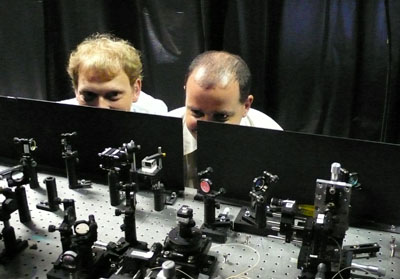Highlights
CQT researchers in New Scientist article on cracking the uncrackable code

CQT researchers Christian Kurtsiefer (left) and Valerio Scarani (right) have explored how sneaky "eavesdroppers" might intercept a supposedly secure quantum communication. Health-and-safety note: the lasers in this quantum optics experiment were switched off, so Christian and Valerio's eyes were safe.
Two CQT researchers have made an appearance in the popular science magazine New Scientist in a feature that profiles the activity of quantum hackers.
The article, titled "Ciphercrime" in print and "Quantum hackers: Cracking the uncrackable code" online, describes how physicists are working to detect and repair weak spots in implementations of quantum cryptography. In principle any attempt to eavesdrop on the distribution of a quantum key should be detectable, but in practice technical details of the setup may sometimes allow an eavesdropper sneaky access.
CQT's quantum optics group, led by Christian Kurtsiefer, collaborated with the feature's main protagonist, Vadim Makarov of the Norwegian University of Science and Technology in Trondheim, Norway, to demonstrate one such hack. The New Scientist article, by reporter Helen Knight, cites this work. The article also quotes CQT's Valerio Scarani.
Indeed, with a quote in the feature's penultimate paragraph, Valerio gets the last word. "It's a natural step in the maturation of a field," he is quoted as saying. "First of all there is enthusiasm, then people start being a bit more prudent, and begin to look for problems so they can be fixed."






